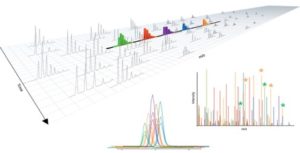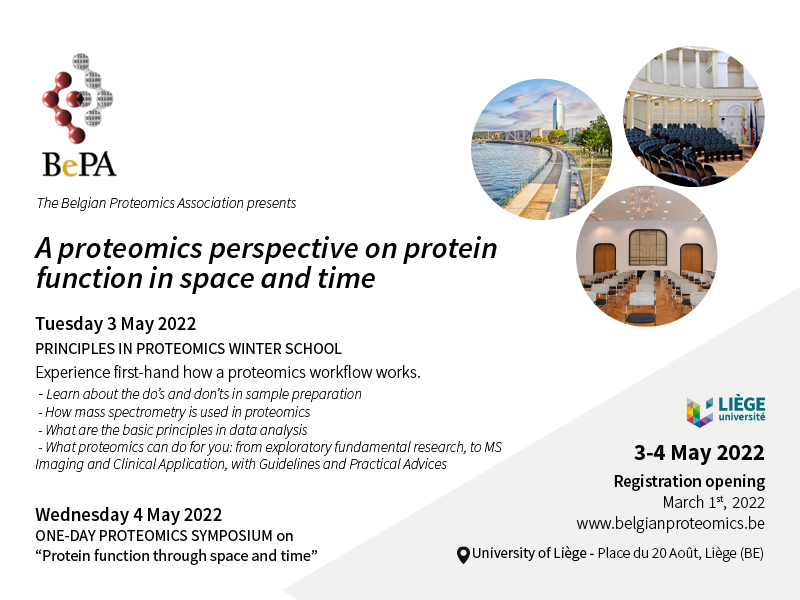Our research
Mass Spectrometry and Proteomics laboratory/platform
IRIBHM, ULB/Erasme
Topics and expertise: cellular signalling and biomarker discovery
Our major goals are to decipher the molecular mechanisms implicated in cellular signalling, as well as to discover novel clinical biomarkers, by using structural and quantitative proteomics (and metabolomics).
We focus on clinical proteomics to discover novel biomarkers by optimizing label-free quantitative SWATH mass spectrometry. Extensive proteomic cartography of body fluids and tissues (biopsies) can be established for each patient presenting a neurological pathology (e.g. multiple sclerosis, acute brain injury, encephalitis) or a non-neurological pathology (e.g. idiopathic pulmonary fibrosis, smoking-dependent cardio-respiratory response). It represents a mandatory step to improve precision medicine for diagnosis, prognosis and therapeutic follow-up. Moreover, the discovery of novel biomarkers will also provide new insights in the understanding of the molecular mechanisms of those diseases. In addition, the development of microfluidic devices will improve sample analysis for fundamental and clinical research.
For example, concerning multiple sclerosis, our neuroproteomics project aims to identify biomarker panels for risk of conversion to multiple sclerosis and for disease severity, by using a novel proteomic approach in the cerebrospinal fluid (and serum). Identified biomarkers, presenting specific post-translational modifications, have the potential to become useful clinical tools for early accurate diagnosis of multiple sclerosis and will also provide new insights into the pathophysiology of neuro-inflammatory disorders.
At a more fundamental level, we have developed over the years an expertise and so a platform, for the study of targeted proteins and complete proteomes by means of chromatography and mass spectrometry. Biomolecules of interest are isolated by electrophoresis, chromatographic purification or co-immunoprecipitation, to investigate their primary structure, their proteic partners, as well as their post-translational modifications (e.g. proteolysis, acetylation, phosphorylation, carbamylation, ubiquitination). Our laboratory started the ULB/Erasme platform for fundamental and clinical proteomics (and metabolomics): recent chromatographic and mass spectrometric strategies optimized in our laboratory are made available to various collaborations via this facility. The main equipment is a SWATH microLC-mass spectrometer (AB Sciex TripleTof 5600) with dedicated bio-informatical tools and various FPLC/HPLC/UPLC liquid chromatography systems.

SWATH analysis, from AB Sciex
Challenges
– To robustly handle with high uptime complex biological samples for fundamental and clinical research
– Identifying and quantifying with confidence thousands of proteins (and their post-translational modifications) or metabolites
– Translate the mass spectrometry approach from biomarker detection to clinical analysis
Outcomes
– Generation of reproducible data from large-scale studies and retrospective data mining
– Discovery of novel partners and post-translational modifications of key molecules implicated in cellular signalling
– Discovery of novel biomarker panels in clinical fluids and tissues for a better understanding and monitoring of human pathologies
The ULB/Erasme Mass Spectrometry and Proteomics platform is a board member of the Belgian Proteomics Association (BePA): https://belgianproteomics.be/expertise/mass-spectrometry-and-proteomics-platform-ulb-erasme/
Group members
 David Communi, PhD, Principal Investigator, Senior Research Associate FNRS (dcommuni@ulb.ac.be)
David Communi, PhD, Principal Investigator, Senior Research Associate FNRS (dcommuni@ulb.ac.be)
phone # +32 (0)2 555 4150
 Carlos Herrera Santacruz, MD, PhD student (acute brain injury neuroproteomics)
Carlos Herrera Santacruz, MD, PhD student (acute brain injury neuroproteomics)
 Laure Bastide, MD, PhD student (multiple sclerosis neuroproteomics)
Laure Bastide, MD, PhD student (multiple sclerosis neuroproteomics)
Nathan Torcida Sedano MD, PhD student (neuroproteomics for refractory status epilepticus).
Virginie Imbault, platform technical manager (biomolecule purification and quantitative proteomics)
Publications
Ten major publications
Karadurmus D., Rial D., De Backer J.F., Communi D., de Kerchove d’Exaerde A., Schiffmann S.N. GPRIN3 controls neuronal excitability, morphology, and striatal-dependent behaviors in the indirect pathway of the striatum. (2019) J. Neurosci. 39, 7513-7528.
Devosse T, Dutoit R, Migeotte I, De Nadai Patricia, Imbault V, Communi D, Salmon I, and Parmentier M. Processing of HEBP1 by cathepsin D gives rise to F2L, the agonist of Formyl Peptide Receptor 3. (2011) J. Immunol. 187, 1475-1485.
Guillabert A., Wittamer V., Bondue B., Godot V., Imbault V., Parmentier M. and Communi D. Role of neutrophil proteinase 3 and mast cell chymase in chemerin proteolytic regulation. (2008) J. Leukoc. Biol. 84, 1530-1538.
Wittamer V., Bondue B., Guillabert A., Vassart G., Parmentier M. and Communi D. Neutrophil-mediated maturation of chemerin : a link between innate and adaptive immunity. (2005) J. Immunol. 175, 487-493.
Vermi W., Riboldi E., Wittamer V., Gentili F., Luini W., Marrelli S., Vecchi A., Franssen J.-D., Communi D., Massardi L., Sironi M., Mantovani A., Parmentier M., Facchetti F. and Sozzani S. Role of the chemoattractant receptor ChemR23 in directing the migration of myeloid and plasmacytoid dendritic cells to lymphoid organs and inflamed skin. (2005) J. Exp. Med. 201, 509-515.
Migeotte I., Riboldi E., Franssen J.-D., Grégoire F., Loison C., Wittamer V., Detheux M., Robberecht P., Costagliola S., Vassart G., Sozzani S., Parmentier M. and Communi D. Identification and characterization of an endogenous chemotactic ligand specific for FPRL2. (2005) J. Exp. Med. 201, 83-93.
Li X., Tjwa M., Moons L., Fons P., Noel A., Ny A., Zhou J.M., Lennartsson J., Ji H., Luttun A., Ponten A., Devy L., Bouche A., Oh H., Manderveld A., Blacher S., Communi D., Savy P., Bono F., Dewerchin M., Foidart J.M., Autiero M., Herbert J.M., Collen D., Heldin C.H., Eriksson U. and Carmeliet P. Revascularization of ischemic tissues by PDGF-CC via effects on endothelial cells and their progenitors. (2005) J. Clin. Invest. 115, 118-127.
Wittamer V., Franssen J.-D., Vulcano M., Mirjolet J.-F., Le Poul E., Migeotte I., Brézillon S., Tyldesley R., Blanpain C., Detheux M., Mantovani A., Sozzani S., Vassart G., Parmentier M. and Communi D. Specific recruitment of antigen-presenting cells by chemerin, a novel processed ligand from human inflammatory fluids. (2003) J. Exp. Med. 198, 977-985.
Autiero M., Waltenberger J., Communi Di., Kranz A., Moons L., Lambrechts D., Kroll J., Plaisance S., De Mol M., Bono F., Kliche S., Fellbrich G., Ballmer-Hofer K., Maglione D., Mayr-Beyrle U., Dewerchin M., Dombrowski S., Stanimorovic D., Van Hummelen P., Dehio C., Hicklin D. J., Persico G., Herbert J.-M., Communi Da., Shibuya M., Collen D., Conway E. M. and Carmeliet P. Role of PlGF in the intra- and intermolecular cross talk between the VEGF receptors Flt1 and Flk1. (2003) Nature Med. 9, 936-943.
Communi D., Vanweyenberg V. and Erneux C. Inositol 1,4,5-trisphosphate 3-kinase A is activated by receptor activation through a calcium:calmodulin-dependent protein kinase II mechanism. (1997) EMBO J. 16, 1943-1952.
Meetings







